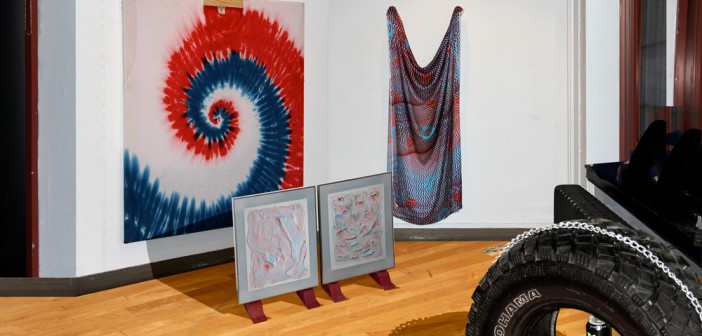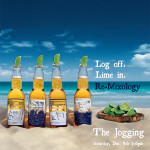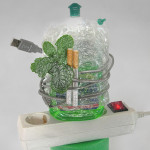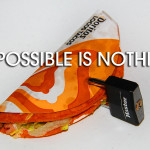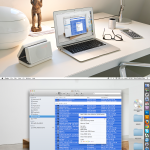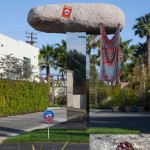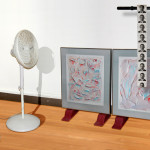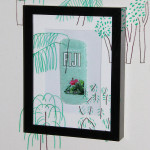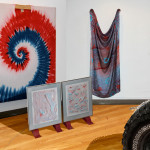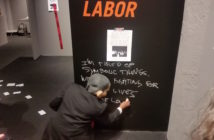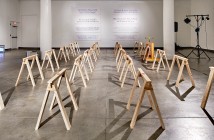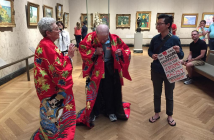In the face of this kind of media saturation, we usually take a defensive posture, blocking out most of the unpleasantness and punctuating the monotony with our own ironic, snarky comments on the proceedings. It’s out of this climate that The Art of Politics emerged, an exhibition of works at MassArt’s Godine Family Gallery by online collective The Jogging.
 glass framed FIJI exterior as whole foods BATH SALT container (8.5 x 11") Carelessly Valuable in an Age of Beauty’s Repression, 2012
glass framed FIJI exterior as whole foods BATH SALT container (8.5 x 11") Carelessly Valuable in an Age of Beauty’s Repression, 2012The Jogging is a collaborative web presence (it’s a Tumblr) originally started several years ago by Brad Troemel and Lauren Christiansen, expanded to include a large and somewhat nebulous number of young artists as participants, most of them exciting and inventive in their individual practices. Members of the group submit to The Jogging under a loose set of parameters, posting sculptural assemblages, digital images, videos, and performance documents more or less daily. The work is topical, consists of throw-away ideas and materials, shows a total disdain for craftsmanship, and usually carries gauchely literal titles, like ALL-PURPOSE WOODEN BRUSH with YELLOW and BROWN Scrubbing Bristles Wearing a PLATINUM BLONDE PAGE GIRL WIG from SPIRITHALLOWEEN.COM. Sources for such sculptural materials include Whole Foods, Hot Topic, bodegas, and internet wholesalers, though you’re just as likely to find repurposed images from Contemporary Art Daily or Gagosian’s website. Works often repeat themselves (a recently recurring element was a plastic Fiji water bottle filled with bath salts), reappearing as branded aftertrails in new posts. Any number of people contribute (most posts carry an alt-code text symbol that acts as a contributor’s signature, linking to their personal sites), but Troemel is one of the most vocal participants about the project, and writes and speaks regularly on the internet and its influence on artistic practice.
The text Free Art is the closest thing to a manifesto for the group. It reads:
In the lives of contemporary artists, Free Art is a place to find one’s self through the existence of others—to individually reclaim the ability to self-mythologize and empathetically pick from your peers for influence. Thus, Free Art is marked by the compulsive urge of searching (or, surfing) to connect with others in a way that is not dictated by profitability, but found and shared charitably among individuals based on personal interests.
The name The Jogging is an accurate reflection of this attitude, which is present in both the making and viewing of the work—steady, leisurely, consistent, marked by things that catch your attention for only a few seconds as you move past them. The subjects and materials present in the work are also appropriate to the name. Like the act of jogging, they show health and fashion consciousness; though not ahead of the curve, they fall in step quickly; they point to suburbanism or semi-urbanism; but above all, they are unabashedly bourgeois. The Jogging tends to be something of a self-aware, visual cultural barometer, and recent posts have been occupied with the media circus surrounding the election, culminating in the collection seen in The Art of Politics.
The Jogging’s preoccupation with consumption, authorship, and taste is an appropriate lens through which to view the election. Attention throughout the race was focused tightly on public opinion rather than issues, arguably affecting public opinion through a representation of itself (very new media theory). Pile on the flashy, alarmist voices and images of the election news cycle, and most people were left bitter and slightly dazed by the end of the season. Social networking sites like Facebook are where some of the most shallow and vitriolic engagements with politics take place, with users sharing badly Photoshopped images beside sourceless information, arguing with friends of friends, and standing only slightly above the fore by making sarcastic, meta-comments on the whole parade of opinions. The Art of Politics engaged not only with the media frenzy of the election but how it is recycled and regurgitated through the web and social media.
Installed in the Godine, a student-run space in the Studio for Interrelated Media at MassArt, The Art of Politics is the collective’s first physical exhibition of work, and it feels like it. Most of the work, while funny and interesting, I’d already seen online, and seeing it in person didn’t do much to add to it. There were a few particularly clever and memorable stand-outs. A police baton skewering two rolls of toilet paper, custom printed with mugshots of Romney and Obama respectively on each ply, makes a vague, ineffectual commentary on the vague, ineffectual attitude of lesser-of-two-evils cynicism. A 6XL blue and white tie-die shirt pulled across stretcher bars like a canvas perfectly synthesizes high and low culture.
The most successful part of the show was a set of videos, attack ads demonizing The Jogging in the terms familiar to anyone who sat in front of a television in November. But they manipulate the language of political mud slinging to address the criticisms that the collective faces: They’re making fools of their viewers, that the saturation of irony found in the project is endemic of a toxic, unproductive culture of hipster-ism, that the work is just plain bad because it’s sloppily executed. A stern voice asks over tense string arrangements, "Why has The Jogging refused to release their original Photoshop documents? What do they have to hide?" It urges America to send The Jogging a message to "start making real art, or get off our newsfeeds."
Another surprisingly polished work is a large digital print of sleek blue and red shapes streaking through a black field. It’s a still from the overblown digital effects of a TV news transition, caught in a moment of abstraction. This has, since the exhibition, become the branding element of the show on The Jogging website, imposed onto stock images of home entertainment centers, or of a toddler playing with a digital tablet.
This image regurgitation is where things get interesting. Some work just looks better on a screen than it does in person, and work from The Jogging aims for this effect. So what was the purpose of the exhibition? It becomes a staging ground for future works. The installation of work in the exhibition space is a kind of raw material for the blog, to be made into new digital mockups and collages. Circulating Tumblr are works from the show, crowded into a single digitally rebuilt space that is better lit and cleaner than the Godine Gallery. Works are resized to appear more impressive. Home Security (Mono-Ha Version),shows a series from the show (ADT home security signs embellished with the trademark Obama red-and-white striped "road to change" logo) digitally tacked onto a Nobuo Sekine sculpture recently exhibited at Blum and Poe (the high-resolution image likely pulled from Contemporary Art Daily). A few weeks after the show, work is starting to drift out of context and into the Jogging formula of piled-on references, where it’s perhaps most potent.
As I mentioned, this is the first time The Jogging has shown their work as physical objects in a space. It’s unusual that they chose to have an inaugural show outside the art world center, New York, and in a small student gallery in our satellite city of Boston. If the opening turnout was any indication, it’s likely an overwhelming majority will see the show online rather than in person.
The Jogging has organized exhibitions in the past, but not of physical works. An Immaterial Survey of Our Peers, a group show curated by The Jogging, placed digital images of the selected artists’ works into a virtual simulacrum of the School of the Art Institute of Chicago’s galleries, images which were then projected into the actual gallery. Artists often wrestle with the dilemma that with good lighting, a decent digital camera, and Photoshop, documentation of work can look better than the real thing. An Immaterial Survey embraced that dilemma by bringing both gallery and artwork together digitally, under "ideal" conditions
Another slightly more extreme precedent for the exhibition could be found in Saint Lawrence Ice, a show curated by Ben Schumacher, whose own sculptures function similarly to The Jogging in a space between object and image. The show, which included work by Jogging artists Brad Troemel and Artie Vierkant alongside artists with a more plastic, but no less inventive approach, including Carol Bove, Hugh Scott-Douglas, and Jo-ey Tang, was staged for a single day on Wolfe Island, in rural Ontario. The sculptures and assemblages were set on the frozen surface of Lake Ontario, and while it’s unlikely anyone but the artists actually saw the work, the show was documented and shared with the world through Tumblr. Documentation is crucial to Schumacher’s work; he treats it as another layer of assemblage, adding watermarks and signatures to images of his sculptures. Jogging artist Artie Vierkant employs a similar strategy with his wall-mounted Image Objects, gradient prints on custom-cut Sintra that are modified in Photoshop so subtly it’s hard to tell what’s real and what’s fake. This concern with the documentation of an artwork, with its online reception, its digital life reflects a growing preoccupation with web presence in all facets of our digitized culture. In many ways the image-object approach can be read as a criticism of this relationship between self and web-identity. The mixture of pleasure and distrust elicited by the doctored images of artworks is very much in line with our growing dependency on and revulsion for sites like Facebook, and the begrudging impulse to represent ourselves and our interests through them.
In the past, The Jogging, as a project, eschewed this kind of criticism for a more positive outlook. More important than the problem of image vs. object is the idea that through the web, the acts of making, viewing, and sharing are similar, far more so than in the maker/viewer relationship in traditional practice. Submissions to The Jogging by other Tumblr users is common. Reblogging and quoting are vital to the project and a creative exercise in their own right. Works lose their tags and credits, wash up on the blog of some teenager in Middle America with no background in art. Anyone could make a Jogging sculpture. You could probably make one in five minutes at your local Rite Aid.
There’s a liberating democracy to The Jogging, but is it wholly meant? When Brad Troemel glues a Hot Topic hair extension to a Whole Foods hat, isn’t he making fun of both brands, and the people who subscribe to them? The concept of branding is hugely important in this oeuvre, and the extreme focus on branded elements reveals their ubiquity where they could otherwise be overlooked. It’s a pop tradition, to force the viewer to look closely at the thing they’d prefer to quickly swallow as something embedded in their routine. But there’s also an element of "taking back" the things that are forced on us, and making something new, however awkward, from them.
Having seen The Art of Politics, and feeling disappointed by the physical installation it’s clear to me that the work on The Jogging is secondary to how the web platform is used. As a blog, regularly checked, The Jogging is terribly interesting to watch: constantly moving forward, producing new rules or phrases in its aesthetic vocabulary. The life of an image can be very short on a site like Tumblr, and aesthetically speaking, a few weeks in the past can be ancient history for The Jogging.
One of John Baldesaari’s three rules to being a successful artist is ‘Talent is Cheap.’ Now it would seem ideas are also cheap. With The Jogging, it’s not the strength of an idea that warrants attention or a long shelf life, it’s the rhizomatic potential of an image. How well does it, or elements of it, re-circulate, producing new avenues for experimentation? How does it stand stripped of context, or weighted with new layers of meaning? This is not only an underlying problem of the image in the digital age, but of the artist in an increasingly compartmentalized yet global world. How well can an artistic practice withstand translation out of its place of origin onto a global stage, or more realistically, a thousand smaller stages around the world? Inversely, how well can an artwork or artist adapt to new contexts, taking on new styles or languages, without losing integrity? These are sink-or-swim questions for artists and cultural workers today.
It’s also become increasingly true that the majority of looking among artists and curators, as well as the general public, is done online and not in person. The Jogging is merely proposing that we treat this dominant platform as a primary mode of both viewing and production instead of a secondary one. We’re past the trope of an online exhibition because an exhibition is inherently a spatial proposition, and translating it to a web page still favors spatial questions that aren’t relevant to that platform. The Jogging instead responds to the particular qualities of Tumblr, simultaneously linear and disjointed, as a means of dialogue. Rather than creating or displaying a grouping of works around an idea, The Jogging imbues each work with a set of ideas or traits holistically, which are then passed on, discarded, or built on over time, like a complex visual game of telephone. It mirrors how specific trends and style as a whole develop and evolve online.
The same rules of taste apply in an election, as in any question of public opinion, and as much as we like to think of ourselves as well informed within our own communities, it’s undeniable that a large number of Americans choose their president the way they choose their brands. The Art of Politics underpins this narrow divide between real and superficial ideology, and it does so in a way that is knowingly superficial. The Jogging has tackled this kind of half-earnest look at democracy and its inherent frustrations before, in an event called ASSEMBLY.
Originally hosted on the site jstchillin.org, a platform for artists’ web projects, ASSEMBLY invited visitors to vote on which institution or individual would be subject to a Denial of Service through mass-visitation, disabling the chosen site for a day. What followed is a little convoluted, but JstChillin’s host site caught onto the activity, the project was moved to The Jogging, which got itself deleted rather than abandon the project. Troemel framed the Denial of Service action as the web equivalent of a sit-in protest of the Civil Rights Movement. Framed as a symbol of democratic power on the web, ASSEMBLY was in reality a completely insular internet art project that just happened to get noticed by people who took it seriously. No particular issues were raised by the action; the action itself was the message. The site with the most votes to be disabled was Rhizome, followed by Troemel’s own Jogging. The only way the project could be considered successful is if it is viewed as an illustration of the futility of protest.
And this is the feeling The Art of Politics left me with. Futility compounds upon futility, an action slated to fail does so unimpressively, creating a sensation wherein it’s difficult to trust the work or one’s own opinions on it. In a way this was even more pronounced online than in the exhibition. Following The Jogging on Tumblr through November meant regular updates of politically oriented works in new contexts, a repetition of the same bad visual gags along the election theme. The experience was uncannily similar to the exhaustion of similar images and rhetoric in the larger public sphere. But I see this not as a failure of the project, but as a success of The Jogging as cultural critique.
In an irony-saturated culture, the viewer has to tread lightly, mindful not only of the authenticity of images and ideas, but their intentions as well. This visual doublespeak, used so often in advertising, corporate language, and political platforms, can make for powerful stuff when used discerningly within an art practice. The cerebral exercise of pulling apart a Jogging project (layers of real vs. digital, sincere vs. ironic, original vs. knock-off), requires a mixture of invested scrutiny and cool detachment that is indicative of our culture as a whole.
Indeed, it seems now the only position of meaningful dissent left to the artist who work within the margins is an ironic one. One need only look at the carnival of art and money that is Miami in early December. Projects like Jonathan Horowitz’s "Free Store" that took place in Miami represent how quickly and cynically the commercial art system can co-opt socially and politically engaged art practices. Wherein most events of this nature offer visitors a free meal or meaningful social exchange, the project, a partnership with sleek, expensive, art-as-fashion publication Visionaire, is essentially a swap meet for rich people, featuring personal items of Givenchy's Riccardo Tisci and REM’s Michael Stipe.
In contrast, The Jogging, in conjunction with Chelsea gallery Stadium, hosted Re-Mixology at a Miami beachfront, billed as "an exhibition (and sampling) of cocktails by The Jogging." Advertised with a series of hokey, Corona-style ads featuring beachside lounge chairs, the event was more than likely a perfect storm of people who were in on the joke, and people who emphatically were not.
Re-Mixology co-opts the language of the hyped-up, over-branded art-parties that surround the fairs and threaten to strangle any shred of credibility out of them. It’s promising to see The Jogging again step out of their web presence in this way, and the collective’s adaptability to new venues and subjects promises an ongoing, rich tradition of ironic critique. The Jogging, like much of what is exciting about internet art or any kind of new art that explores popular culture, is highly skilled at perverse imitation. They identify and retune trappings of culture just slightly, tilting them so they can be seen in a different, slightly uncomfortable light. They do this formally with Photoshop filters and awkward stock images, and they do it conceptually by mastering and regurgitating new languages of advertising, Etsy listings, "green" culture, DIY culture, and most sagaciously, of the art world itself. At its worst an over-educated, self-inflated culture too cynical to confront its own faults, the art world is perhaps the most in need of this kind of critique.
- “On Saturday the 8th of December from 3-6 pm we invite you miles away from ordinary to ‘Re-Mixology’, an exhibition and sampling of designer cocktails created by The Jogging. With drinks best suited on either a pedestal or a coaster, let your tastes travel and find our beachfront event for some intelligent night (afternoon) life. So join us and take a moment to relax responsibly and finally catch up with old and new friends after a day consumed by art without leisure.”
- Attached Files (version), 2012 Sculpture
- DORITOSLOCOS taco MASTER LOCKED shut (Key Sold Separately) Highly Significant, 2012
- Garnier Nutri Gro-Light Planting System (Parsley), 2012, Houseware
- Performance (Open All Files), 2012, Laptop, files. Duration variable.
- Home Security (Mono-Ha Version), 2012 Installation Shot from The Jogging: The Art of Politics.
- The Jogging: The Art of Politics, 2012 Installation View
- Jogging on The Jogging, 2012 Performance
- glass framed FIJI exterior as whole foods BATH SALT container (8.5 x 11″) Carelessly Valuable in an Age of Beauty’s Repression, 2012
- Jogging: Art of Politics, 2012 Installation view

